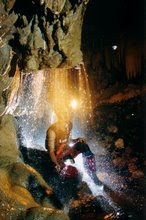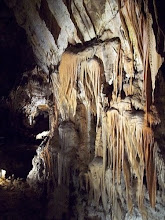On the geological map, made and
issued by the Directorate General of
Geology and mineral Resources,
Ministry of Mining and Energy,
drawn on the scale 1:100.000 for the
islands of Java and Madura and on a
scale of 1:250.000 for the thousands
of other islands, it becomes apparent
that Indonesia possesses at least
154.000 Km2 limestoneand
dolomite.This wasofficially
announced by the Minister of is welcome
address at the national workshop on
the karst Environment, held in
Jakarta on September 29-30,1999. This vast amount indicates a
fantastic wealth of 39,37 trillion tons of limestone reserves in
Indonesia was estimated at only 20
Indonesian Speleological Activities
(FINSPAC), in Indonesia Known as
Himpunan Kegiatan Speleologi
Indonesia (HIKESPI), in 1983, the
Indonesian government and nearly
all Indonesian scientist consider
karst only having economic value as
a mineral resource, which can be
exploited unrestrictedly
It is truly the ultimate result of
FINSPAC/HIKESPI continuous and
consistent campaigning on the
multiple values of karst and caves,
that the minister of Mining and
Energy has conceded to organized
this National Workshop on the karst
Environment, thereby approving the
principle of limestone resources
management based on environment
consideration. As someone who
loves nature, in his welcome address
he uttered his delight to be amongst
the experts in geology, geography,
mining, hydrology, speleology,
archaeology, biology, tourism,
forestry,
agriculture, and
environment, who all have one
single target in mind, namely how
to utilize and manage karst
resources holistically,
and
interdisciplinary in a coordinative
way.
The outcome ofthis Workshop was
a Ministerial Decree on Karst
Management , the essence of which
is the National Classification of
Karst Resources in class 1, 2 and 3.
Only class 3 karst may be mined.
Class I conserved, and absolutely
prohibited to be mined. Class 2 only
allowed to be mined under strict
conditions.
It is unfortunate indeed, that
before this Ministerial Decree
could be in force nationally, he
was not reelected. The new
Minister of Mining and Energy is
however willing to escalate this
Ministerial Decree to a
Presidential Decree, a closer step
towards a Karst Law
We urgently need international
funds and the assistance of
international karst experts to create
a data base on Indonesian karst and
caves, in order to protect this, in
many locations, vast dwindling
nature resource, due to extensive
mining for cement and "marble".
INTRODUCING INDONESIAN
KARST AND CAVES
To comprehend how large and
widespread the karst areas are and
how many limestone caves there are
in Indonesia, it is mandatory to
describe in a concised way that
Indonesia consists of more than
13,000 islands, stretching 6,400 km
from West to East, occupying one-
seventh of earth surface
This sprawling island chain
encompasses mind-stupefying
extremes: 5,000 m high
snowcapped mountains of Papua
(Irian Jaya), most of which are
karst, sweltering lowland swamps
of eastern Sumatra, windy
savannahs in Timor's karst, lush
rainforests of East Kalimantan's
very hard-to-reach interior, with an
incredible unexplored karst
formation larger than West Java.
Major karst areas are found in Java.
Kalimantan, Sulawesi and Papua.
Many smaller islands consist mostly
of karstified limestone, like Madura.
Nusa Penida, Sumba, Sawu, Togian,
Kai, Kabaena, Muna, Buton, Biak.
Most well known karst areas are
the (I) classical tropical conical
karst Gunung Sewu, Java, made
world famous by J. V. Danes
(1910: Die Karstphenomene im
Goenoeng Sewoe auf Java), H.
Lehman (1936: Morphologische
Studien auf Java), H. Flate and D.
Pfeffer (1962: Grundlage der
Hydrogeologischen Verhaltnisse
im Gunung Sewu, Java) and
Jennings (1971), (2) the cockpit
karst of south Gombong. Java, (3)
the tower karst of Maros-Pangkep,
Sulawesi, (4) polygonal highland
karst of Papua, and (5) the
spectacular karst formation of East
Kalimantan.
There is considerable variation in
the age of carbonate rocks in
Indonesia, the oldest of which are
the dolomites in the central
mountain range of Papua, devon
(410-360 million years) and the
Carstenz Pyramid, late neogen (95
1,7 million years). A list was
published by the Geological
Research and Development Center
stating the different ages of
carbonate rocks in Indonesia,
ranging from Mesozoicwn
(estimated) 18.344 km2, Tertiary,
119.877 km2, Quarternary 15.811
km2.
There is also considerable variation
in thickness of karstified carbonate
rock formations, ranging from
shallow in small islands like Nusa
Barnng and Nusa Penida
(merokarst-Cvijic) till great depth
extending under sea level in major
karst areas of papua ,jawa,sulawesi and kalimantan
(holokarstC vijic) with off-shore
springs.
Only karst formations, hard to
reach, uninhabited or sparsely
inhabited, are covered by dense
primary forests. Where karst areas
are densely populated and
accessible by roads, deforestation
is the rule. Concomitant quarrying
of limestone for road hardening,
building material and industrial use
is evident in many locations.
Biodiversity in limestone areas all
over Indonesia and endemism of
karst flora and fauna have just
recently interested a very few
biologists. In big contrast to
Malaysia, where some biologists
have already succeeded in
documenting hundreds species of
endemic plants and animals. Cave
dwelling bats and swiftlets are the
only creatures getting sufficient
interest from two biologists from
the Biological Research and
Development Center of the
Indonesian Science Institute. For
an immense karst treasure so
widely spread, so diverse and so
abundant, potentially so important
To yield expensive decorative and
medicinal plants, also rare and very
expensive edemic karst fauna (like
the beautiful butterflies from
Maros at Bantimurung Nature Reserve),
it is really uncomprehensible that only so few
Indonesian scientists are interested
to study the interesting Indonesian
endo- and exokarst phenomena.
Only a very few Indonesian
geologists in the late nineties,have
shown interest in karstology and
speleology. Even presently, no
geologist has dared to venture
deep into caves like for instance
the French, British and Italian
geologists exploring caves in
Indonesia with Finpac's
assistance.
Not one of the 3 known Indonesian
PhD's in Karst Hydrology, has
extensively scrutinized and publish
the different flow patterns of
underground rivers in all major
karst areas. No data on off-shore
karst spring wells / which could
easily be revealed through infrared
remote sensing
Indonesian archaeologists were
fascinated by the handprints, so
frequently found in many caves in
East Indonesia they did not
anticipate that the caves in the
interior of East Kalimantan, so
intensively surveyed by French
speleologists, yield the most
abundant cave wall paintings and
handprints in the world
Karst tourism in Indonesia is only
known in Maros (Bantimurung
waterfall and cave). No other karst
formations have attracted anyone
to develop them as tourist
attraction. Only a handful of
decorative caves are open to the
public, all badly managed and
decaying, due to over" visit and
design overkill The whole word knows, that
Indonesia possesses several tree
species which grow profusely in
certain karst areas and are very
expensive, due to its superb quality
for building material and furniture.
They are Teak (Tectona grandis),
Mahogany (Switenia mahagoni),
Black wood (Diospyros celebica
Bakh). There are also tree species,
so expensive that their scented
wood are sold per gram: Gaharu
wood (Aquilaria malaccensis and
A.vilaria)and Sandalwood
(Santalum album)
It is very regrettable that in this
"reformation era" more and more
trees are being felled illegally. In
East and Central Java, teak are
very extensively stolen.
Sandalwood and Gaharu trees are
in danger of extinction. Black
wood are cut down completely in
many parts of Sulawesi. It is very
difficult to cultivate different
species of these endemic karst
plants, since it is not sure that they
grow well on other karst areas, let
alone on non-kart areas.
With the disappearance of endemic
trees and plants, endemic fauna
will become extinct also Whole
karst ecosystems will become
disrupted.
Many caves were used by
prehistoric animals and men in the
past, thriving in a very different
climate and environment. The past flora and fauna environment at the
Gunung Sewu karst can even be
reconstructed by reading Jughuhn's
travel report through this area in
the eigtheenth century.
In the nineteen sixtieth, the first
cement factory opened at Gresik.
At that time no environmental
impact analyses was required. But
since then annual escalation of the
cement production was the rule. In
the ninetieth all karst formation in
Gresik have been used up, while
production was already targeted at
20 million tons cement annually.
So a new plant was required in
nearby Tuban, using karst, so important hydrologically.
The team of experts, consisting
nearly all of mining engineers, not
any of them karst and cave
scientists, no one ofthem entering
water caves to map the
underground river courses and
calculate their water debit, made
the environment impact analyses,
which was questionable, inaccurate
and incomplete, but nevertheless
the cement factory was allowed to
start producing. Within only ten
years, the amount of Tuban
limestone quarried, was nearly
exhausted and recently a plan to
mine the karst at Citeureup in far
away West Java for this factory, is
being negotiated. The team of
experts making the environment
impact analyses and the team in
charge of commenting it,
onceagain did not consist of karst and cave scientists. No
biospeological survey was
performed. No accurate data on the
cave dwelling bats and swiftlets.
Karst ecosystem in situ was not
surveyed. Worst, no valid data on
karst hydrology and endokarst
phenomena were presented and
commented.
Gresik cement factory is now only
one of very many cement factories
already in operation in west,
central and east Java, west and
north Sumatra, south Sulwesi, west
Timor, and other islands.Even the
tiny island of Nusakambangan in
the south of central Java is being
quarried intensively.
South Gombong karst, the most
important karst water resource in
the island of Java,
geomorphologically very important
since it is the only cockpit karst in
Indonesia, was the next target in
1993. All experts recruited by
FINSP AC, consisting scientists in
relevant diverse fields (speleology,
soil science, geology, geography,
hydrology, nature conservation,
forestry, biology, ecology etc)
The dilemma is however the lack of
experts in Indonesia to perform the
complicated environment impact
analyses and the experts who are
responsible to evaluate this
analyses and to give their unbiased,
objective scientific comments.
Local governments, so euphoric in
getting their autonomy due to
decentralization of bureaucracy,
are less equipped to objectively
make their final decision.
Scientists all over Indonesia are
just now beginning to appreciate
the many virtues of karst, thanks to
the constant and consistent effort
of FlNSP AC to inform nationwide
the importance of karst at many
occasions and at the National
Karst Environment Symposia,
organized twice in 1985 and 1998,
proposed by FINS PAC's president
and sponsored by the minister of
forestry Several field trips and concomitant
scientific meetings to the Gunung
Sewu, South Gombong and
MarosPangkep karst. were
performed with FINPAC's
constant involvement since 1993,
taken part by many scientists in
related fields









